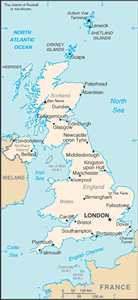The Geography of The United Kingdom
The Geography of The United Kingdom
British Geography
Location: Western Europe, islands including the northern one-sixth of the island of Ireland between the North Atlantic Ocean and the North Sea, northwest of France
Geographic coordinates: 54 00 N, 2 00 W
Map references: Europe
Area: total: 244,820 sq km land: 241,590 sq km water: 3,230 sq km note: includes Rockall and Shetland Islands
Area - comparative: slightly smaller than Oregon
Land boundaries: total: 360 km border countries: Ireland 360 km
Coastline: 12,429 km
Maritime claims: territorial sea: 12 nm exclusive fishing zone: 200 nm continental shelf: as defined in continental shelf orders or in accordance with agreed upon boundaries
Climate: temperate; moderated by prevailing southwest winds over the North Atlantic Current; more than one-half of the days are overcast
Terrain: mostly rugged hills and low mountains; level to rolling plains in east and southeast
Elevation extremes: lowest point: The Fens -4 m highest point: Ben Nevis 1,343 m
Natural resources: coal, petroleum, natural gas, iron ore, lead, zinc, gold, tin, limestone, salt, clay, chalk, gypsum, potash, silica sand, slate, arable land
Land use: arable land: 23.23% permanent crops: 0.2% other: 76.57% (2005)
Irrigated land: 1,700 sq km (2003)
Natural hazards: winter windstorms; floods
Environment - current issues: continues to reduce greenhouse gas emissions (has met Kyoto Protocol target of a 12.5% reduction from 1990 levels and intends to meet the legally binding target and move toward a domestic goal of a 20% cut in emissions by 2010); by 2005 the government reduced the amount of industrial and commercial waste disposed of in landfill sites to 85% of 1998 levels and recycled or composted at least 25% of household waste, increasing to 33% by 2015
Environment - international agreements: party to: Air Pollution, Air Pollution-Nitrogen Oxides, Air Pollution-Persistent Organic Pollutants, Air Pollution-Sulfur 94, Air Pollution-Volatile Organic Compounds, Antarctic-Environmental Protocol, Antarctic-Marine Living Resources, Antarctic Seals, Antarctic Treaty, Biodiversity, Climate Change, Climate Change-Kyoto Protocol, Desertification, Endangered Species, Environmental Modification, Hazardous Wastes, Law of the Sea, Marine Dumping, Marine Life Conservation, Ozone Layer Protection, Ship Pollution, Tropical Timber 83, Tropical Timber 94, Wetlands, Whaling signed, but not ratified: none of the selected agreements
Geography - note: lies near vital North Atlantic sea lanes; only 35 km from France and linked by tunnel under the English Channel; because of heavily indented coastline, no location is more than 125 km from tidal waters


